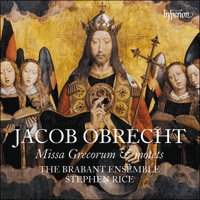Texte paru dans: / Appeared in:
Hyperion |
|
|
Reviewer: Barry
Brenesal
My first recollection of
hearing Obrecht’s music was in 1971, when I was a student of Dr. Walter
Welch, curator of the Syracuse University Audio Archive at that time. Welch,
who had been a gofer for Edison in his final years (he referred to himself
with sly wit as “Edison’s last pupil”) had a knack for dramatic display,
even as he taught me the occult art of analog tape editing. He used two
recordings of the Agnus Dei from Obrecht’s Missa Malheur me bat on separate,
synchronized, 78-rpm playback machines to demonstrate perceived binaural
sound. (He also used two copies of Pasquale Amato singing “Eri tu” to
illustrate this concept with acoustic platters.) The Obrecht, recorded in
the early 1930s in muddy, distant sound by Ludwig Berberich and the Munich
Cathedral Choir, assumed considerable depth and a degree of spaciousness in
this arrangement. I regret to note, however, that the music itself made
little impression upon me. It was not until I heard that Mass live and
complete, as well as other works by Obrecht several years later, that I
became aware of his remarkable skill—not simply in erecting huge,
intellectually brilliant formal edifices, but the delicacy of his part
writing, his graceful ingenuity at variation, and the sureness of his
melodic invention.
It’s fair to say that not
everybody agrees with this assessment. Most notably, Reinhard Strohm, in his
deservedly influential The Rise of European Music 1380–1500, took exception
to what he called Obrecht’s “ubiquitous parallel tenths between outer voices
… the inclination towards strict sequential patterns. These devices
contradict the ideal of varietas as pronounced by Tinctoris,” not mentioning
in this context that Tinctoris singled Obrecht out by name as one of the few
contemporary masters “whose compositions, distributed throughout the world,
fill God’s churches, the palaces of kings, and the houses of private
individuals, with the utmost sweetness.” This is the first complete recording of the Missa Grecorum. No date for the work, no explanation for its title, nor any provenance for its thematic cantus firmus, has been established. Rob Wegman, author of a monograph on the author and his Masses, suggests approximately 1490. It is a mature composition notable for its textural and contrapuntal variety, and brilliant handling of motivic transformation. The complexity of Obrecht’s formal structures and the inspired solutions he finds to the tasks he sets himself typically draw all comment; and the temptation to do this while contemplating the Missa Grecorum certainly exists—as would, no doubt, the tendency of readers who would study such material to view Obrecht’s music as a crystal palace of mathematics. So instead, I will just note that one of the Mass’s many notable moments is a relatively simple procedure in the sparingly conceived Et incarnatus est section of the Credo. A three-note motif of an ascending or descending 3:1:2 pattern moving through various voices eventually vanishes against the augmented cantus firmus, which, coupled with the repeated, concluding phrase et sepultus est and a cadential modal shift, generates a sense of acutely intimate reverence. In this, as much as in the numerologically based games that frame this Mass’s movements, we can find Obrecht.
The rest of the album is taken
up with five seldom heard selections by the composer. O beate Basili is a
vigorously enthusiastic four-voice polytextual motet in three sections that
first appeared in Petrucci’s 1505 Motetti libro quarto. Obrecht’s alternatim
setting of the Salve Regina antiphon is in turn worthy of its haunting
plainchant. Its four sections whose ambit move from contemplative to
ecstatic show a masterful handling not simply of textures, density, part
movement and harmonic release, but of expressive control. The fragmentary
motet Mater Patris/Sancta Dei genitrix was written for five voices, though
the contratenor II part has long gone missing. It is a particularly fine
example of Obrecht’s handling of textures: sometimes homophonic in a way
that recalls contemporary Flemish folk song, but upon other occasions
pitting what we would call two melodic and tonal centers (and occasionally,
three) against one another. The Cuius sacrata viscera is a miniature motet,
in a setting here for four voices that is over nearly before it’s begun.
Finally, there’s an anonymous Agnus Dei found in the Wrocław Codex (a
mensural codex from the turn of the 15th century and into the 16th)
currently at the Warsaw University, which Wegman attributes to Obrecht. Its
outstanding feature is a G-F-G ostinato in augmentation in the superius in
the first section on five ascending pitches, which is reversed in the second
section. It works against the sometimes sprightly imitative passages and
rhythmic byplay of the other voices, to intriguing effect.
I’ve previously reviewed three
recordings featuring Stephen Rice and his Brabant Ensemble. Theirs is a
14-voice SATB choir on this album. Clean enunciation is sometimes lost, but
never the absolute beauty of the voices in perfect balance with one another.
Unlike their release of motets by Mouton (Hyperion 67933), textures are
always clear, which is very important in Obrecht’s frequently complex
passagework. Rice strives at all times to clarify rhythms, and phrases
appropriately for the composer’s lengthy musical line, a characteristic he
shares with Ockeghem. The sound possesses fine definition. In short, this is a welcome addition to the relatively small index of albums devoted to Obrecht. Definitely recommended, with hopes of more to follow. | |
|
|
|
|
|
|
|
Cliquez l'un ou l'autre
bouton pour découvrir bien d'autres critiques de CD |
|




